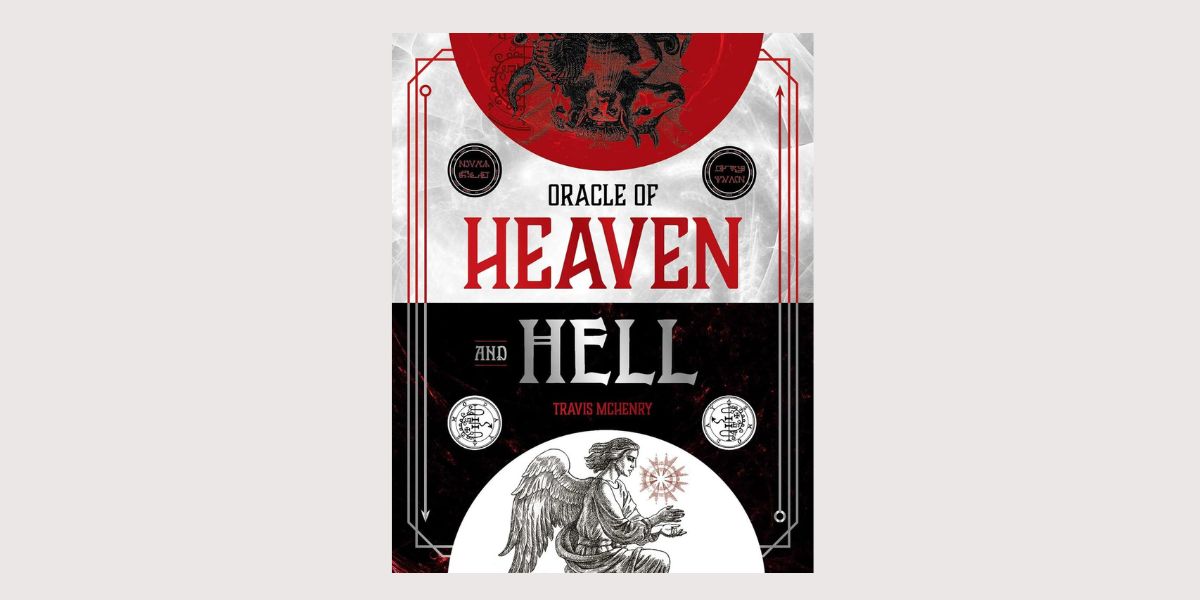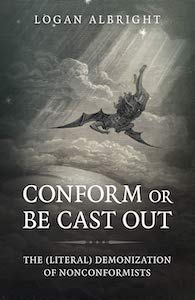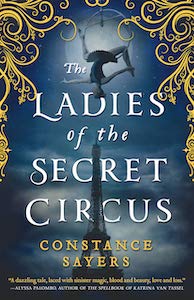
Oracle of Heaven and Hell: Harness the power of the angels and demons, by Travis McHenry
Rockpool Publishing, 1922785334, 168 pages, 72 cards, April 2024
Few oracle decks have dared readers to plumb the depths of the abyss, to dance on the razor’s edge between good and evil, as boldly as Travis McHenry’s Oracle of Heaven and Hell. In the tradition of grimoire magic, this unique deck conjures up Kabbalistic angels and their rival Goetic demons. Each card presents a dual-sided portrait: a divine messenger on one side, a primordial agent of chaos on the other. These celestial and infernal beings, bound by their opposing sigils, clash and coalesce in a cosmic dance of light and shadow, their wings and claws creating a maelstrom of energy that mirrors the profound duality inherent in the human soul. The cards’ edges, gilted in metallic blood-red, scintillate while shuffling, and the backs bear the sigil of Asmoday, the King of Demons, a potent symbol of forbidden knowledge.
Travis McHenry, a former intelligence analyst for the United States Navy and ordained Baptist deacon, traded his military uniform for the robes of a ritual magician. With a university background in anthropology and a Nile baptism initiating him into the priesthood of Anubis in 2021, he continues to explore the depths of the mysteries.
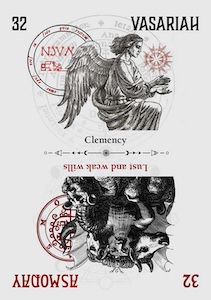
McHenry is the creator of a variety of tarot and oracle decks, including the Vlad Dracula Tarot, Hieronymus Bosch Tarot, and Egyptian Star Oracle. I’ve been using his Angel Tarot and Occult Tarot to learn the Kabbalistic angels and Goetic demons, so I was thrilled to discover that he has released Oracle of Heaven and Hell, a deck that combines the monochrome artwork from the previous ones, presenting each angel and corresponding demon on the same card, with their sigils popping in a rich sanguine red. This comprehensive deck is a wonderful resource for occultists who want to deepen their understanding of the interplay between these opposing spiritual forces.
As McHenry notes in the introduction, “There can be no light without darkness and no darkness without light.” [1] The accompanying guidebook delves into the origins of the 144 spirits featured in this deck. The 72 Kabbalistic angels, also known as the angels of the Shem HaMephorash, or secret name of God, are divine emanations whose names are derived from the 72-letter sequence found in verses 19-21 of the Book of Exodus, chapter 14, which describes Moses pronouncing the divine name and God parting the Red Sea for the Israelites.
These angels have dominion over the 72 Goetic demons, who come from the medieval grimoire The Ars Goetia, or The Lesser Key of Solomon. These spirits are believed to be derived from pagan gods, fallen angels, and other infernal spirits. According to legend, they were first summoned and enslaved by King Solomon, who forced them to build his temple. After the work was completed, Solomon imprisoned them in a brass vessel sealed with a magical sigil and cast them into a Babylonian lake. When some treasure hunters discovered it and broke the seal, the demons were released into the world.
According to the occult writings of Cornelius Agrippa, every human is protected by a trio of guardian angels. In McHenry’s guidebook to Oracle of Heaven and Hell, each entry includes the dates and times over which each spirit holds regency so readers can discover their three guardian angels based on their birth date and time. Each demon is also said to be a servant to those born during certain date ranges.
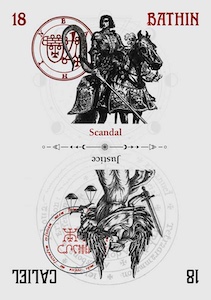
A potential drawback for those who don’t own McHenry’s previous decks, the Angel Tarot and Occult Tarot, is that the guidebook for Oracle of Heaven and Hell does not provide pronunciations of the spirits’ names, which were included in the other guidebooks. This could present a minor challenge for those unfamiliar with Kabbalistic angels and Goetic demons. However, each card offers simplified oracular meanings in the form of one or two keywords, making it accessible to a wider audience.
I regrettably found a spelling error on one of the cards: the name of the first angel, Vehuiah, is misspelled Vehuaih. While this is a minor oversight, it’s worth noting for those who appreciate accuracy and attention to detail. Hopefully, future printings will remedy this mistake.
When I first opened Oracle of Heaven and Hell and held the cards, I felt intense power emanating from them. It was like the angelic and demonic energies were wrestling with each other in the cards. The more I work with this deck, the more I see the angels and demons as complementary opposites, the angel representing a higher state of consciousness and the demon being a primal, instinctual response.
To quote William Blake’s Marriage of Heaven and Hell: “Without contraries is no progression. Attraction and repulsion, reason and energy, love and hate, are necessary to human existence. From these contraries spring what the religious call Good and Evil. Good is the passive that obeys reason; Evil is the active springing from Energy. Good is heaven. Evil is hell.”1 Blake eloquently illustrates how the primal tug of war between heaven and hell sparks the Promethean fire of inspiration, the creative tension that fuels all artistic endeavors. The angels and demons represent a delicate balance between rational consciousness and primal instincts.
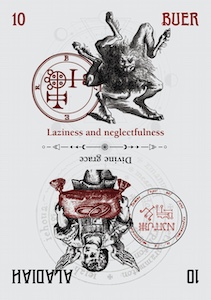
The Oracle of Heaven and Hell has challenged me to develop a more nuanced approach to interpretation. When I draw a card, regardless of whether the angelic or demonic side is upright, I consider both perspectives, viewing them as complementary aspects of the message. This allows me to explore the light and shadow sides of the information I’m seeking.
For example, card 4, which features the angel Elemiah, with the key phrase “Divine Power,”2 and the demon Samigina, with the keyword “Delay,”3 could be interpreted in the following way. Since Elemiah is associated with protection, guidance, and divine intervention, this angel’s presence indicates that the querent is being supported by a higher power and that there is a spiritual purpose for whatever challenges they are facing in their current situation.
The delays and obstacles in their path, signified by the opposing demon, might be frustrating, but may be necessary for personal growth or to help realign the querent’s path with their divine purpose. The overall message would be that a larger, divine plan is at work that involves temporary setbacks or delays, and one must have patience and trust in divine timing, as the delays may be necessary to prepare one for something greater. Even in the face of these challenges, the querent is being protected and guided by a higher power.
One of my daily draws was particularly interesting. After drawing the “Spiritual Communication”4 card, featuring the angel Nanael and the opposing demon of “Ignorance,”5 Camio, I was startled to receive a telepathic message from Asmoday, the demon king, later that day, even though I wasn’t handling the deck or anywhere near it.

Given his sigil’s prominence on the back of every card, it’s not surprising that he reached out to me after I’d been working with this oracle. I was completely relaxed, watching TV at the time, and his communication came in like a jarring intrusive thought. He let me know that he was displeased that I was ignoring him and was demanding my attention by startling me into recognition of his presence. Remembering that the reversed keyword on the “Spiritual Communication”6 card is “Ignorance,”7 this incident brought to my attention how I can be willfully ignorant of spirit contact, either out of fear or distrust.
Be aware that engaging with this deck can open channels of communication with these entities, and I wouldn’t recommend it to anyone who feels uncomfortable with the idea of interacting with demons. When I initially started establishing contact with these spirits (before using this deck), they informed me that calling upon one of them summons them all. The Underworld resides within us.
Oracle of Heaven and Hell is more than just a deck of cards; it’s a portal to the depths of the human soul. By confronting the duality within, you’ll embark on a transformative journey of self-discovery. This powerful tool offers an alchemical transformation, but it demands courage and a willingness to face your inner demons. Approach it with respect and reverence, and be prepared to emerge transformed.

Rachel Christina McConnell is a witch, tarot reader, intuitive astrologer, and writing spider. She holds an MFA in Fiction from Columbia University in the City of New York. Her short stories have appeared in Dark Moon Lilith Press and Minerva Rising Press’s The Keeping Room. Links to her publications are available here: https://rachelchristinamcconnell.wordpress.com
